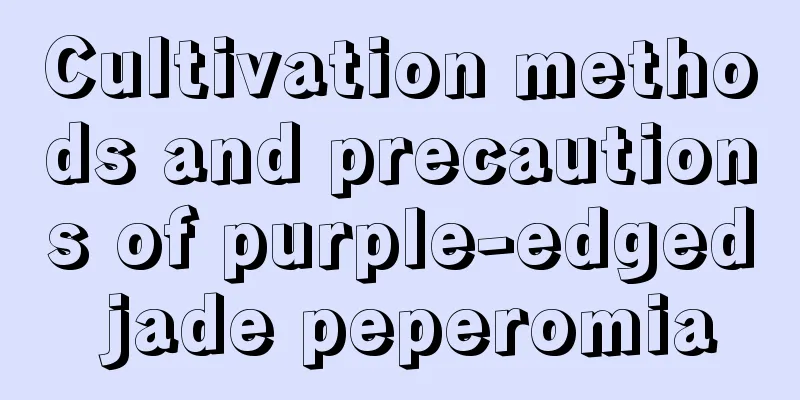Cultivation methods and precautions of purple-edged jade peperomia

1. Maintenance methods1. Temperature: Twenty-five to thirty degrees is more suitable, which can be seen from its distribution range. In addition, it is not cold-resistant, and the cold climate in winter can cause it great harm and may even cause its death. Therefore, try not to drop below ten degrees in winter. 2. Light: It prefers light, and it cannot carry out photosynthesis without sunlight. But direct sunlight can also cause it damage, especially its leaves. Therefore, it is necessary to shade it in summer or move it to a semi-shaded place. In other seasons, it can be placed in a place with sufficient sunlight, and the best lighting time is about six hours. 3. Watering: It likes moisture and has high requirements for air humidity. Therefore, in addition to normal watering, you also need to spray some water when it is dry. 4. Fertilization: It needs fertilizer, but not too much. Normally, it can be applied once every ten days or half a month, but the concentration needs to be strictly controlled, because concentrated fertilizer is very harmful to it. 2. Breeding techniques1. Reproduction: You can use the cutting method. Best time to visit is April to May. Choose top, strong branches, preferably about five centimeters in length. Cut off the lower half of the leaves and leave the upper half. Then, insert it into the sand bed. Note that it is best to insert it at an angle. After about ten days or half a month, it will take root. 2. Repotting: Purple-edged Jade Peperomia has certain requirements on the quality of the substrate. Generally speaking, the frequency of repotting can be two or three years. When preparing, you can use leaf mold, peat soil, perlite, sand and other materials. After repotting, the temperature should be between 18 and 20 degrees, otherwise it will be difficult for the plant to adapt to the new environment. 3. Problem diagnosis and treatment1. Diseases: There are not many types of diseases and their frequency is not high. Occasionally there are "stem rot" and "leaf spot", which can be treated with carbendazim and other drugs. In addition, more attention should be paid to auxiliary measures such as ventilation. 2. Pests: Mainly scale insects and slugs, which can be controlled by various pesticides. IV. Other issues1. Toxicity: It is a non-toxic and harmless variety. Moreover, its ability to absorb harmful gases is very strong. 2. Can it be raised at home? It not only has a strong purifying effect, but also has a great ornamental effect. It is a foliage plant. |
<<: Cultivation methods and precautions of Fugui seeds
>>: Does the Bilei drum prefer yin or yang?
Recommend
How to water the lucky flower and how often to water it
Overview of Smooth Sailing Flower Watering How of...
What to do if gardenia has red spider mites
1. Introduction to pests It is one of the major b...
Does Houttuynia cordata prefer shade or sun?
Does Houttuynia cordata prefer shade or sun? Hout...
How to make Strelitzia grow side buds? Can it grow again after cutting off all the leaves?
1. How to make Strelitzia grow side shoots 1. Pru...
What flowers are the most auspicious to grow in the living room?
1. Good fortune As the name suggests, the flowers...
How to plant blueberry seedlings bought online?
Blueberry is a common fruit with soft flesh, juic...
How to prune green radish
Reasons to prune green radish modeling For other ...
How to use nutrient solution for green radish (soil and hydroponic methods)
1. How to use nutrient solution soil culture Firs...
The difference between rotor lotus and clematis
1. Differences in roots Both belong to the Ranunc...
What is the use of stir-fried dandelions? What is the difference between stir-fried dandelions and not stir-fried dandelions?
1. What is the use The dandelions are cooked afte...
What are the landscape trees?
1. Ginkgo Tree It is both a foliage tree and a fl...
Is cactus a flower? What are its characteristics?
1. Is a cactus a flower? Cactus is a succulent pl...
Peach planting conditions and temperature requirements in the planting area
Introduction to Peach Juicy peach is also known a...
The cultivation methods and precautions of magnolia
1. Maintenance methods 1. Temperature: A warm env...
When is the best month to plant Green Treasure melon?
When to plant Green Treasure melon Green Treasure...









